Liza Lou’s ‘beautiful little bunker’ in Joshua Tree

Simply sign up to the Arts myFT Digest -- delivered directly to your inbox.
“One of the funny things about Joshua Tree is that people like to wear costumes,” laughs artist Liza Lou from her studio, in jeans and a checked shirt, her long blonde hair hastily pulled back. “Everyone puts on their poncho and their hat and they fly their freak flag, whatever it is. I always imagine them driving down from LA, taking off the suit and tie, putting on the feathered hat, sucking on the peyote pipe and having their far-out vision quest. It’s a place where you can come and figure yourself out.”
A hundred and forty miles east of Los Angeles, the southern Californian wilderness of Joshua Tree sits at the confluence of the Mojave and Colorado deserts. Its rugged and remote landscape has long enticed a creative, counter-culture crowd. In the 1960s, singer-songwriter Gram Parsons came to find inspiration for his “cosmic American music” and was infamously cremated in the national park; in the late ’80s, assemblage artist Noah Purifoy began creating junk sculptures on a 10-acre plot of land that would eventually become the Outdoor Desert Art Museum. Today, musicians such as PJ Harvey and Iggy Pop gravitate to local recording studio Rancho de la Luna, while artists including Rachel Whiteread participate in High Desert Test Sites, an initiative creating site-specific works that respond to the desert location.
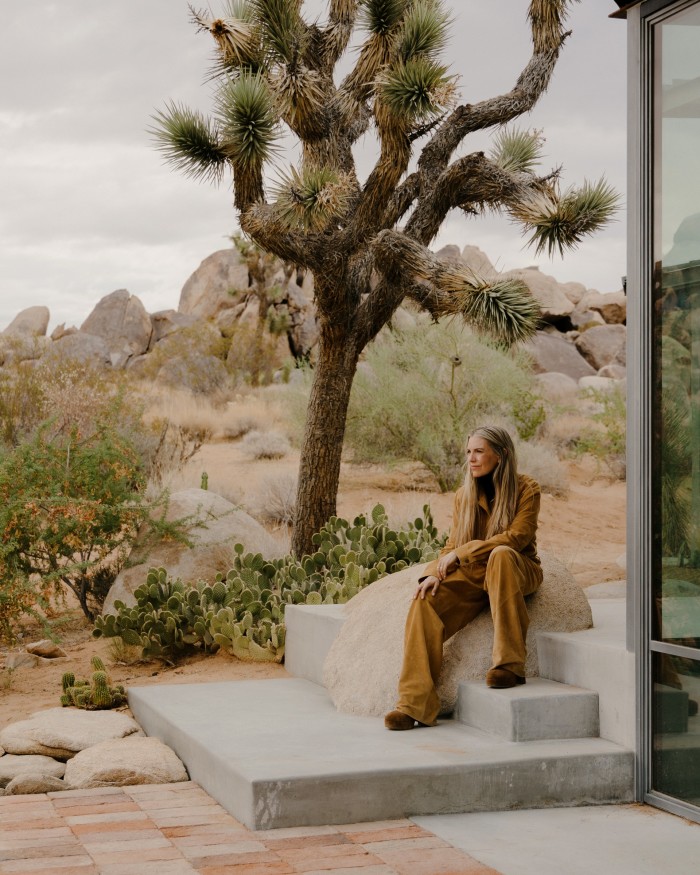
“I think there’s a difference between looking at a landscape and being inside it,” says Lou, whose Joshua Tree home is nestled among a series of dramatic rocky outcrops. “It’s been a really profound experience being out here during Covid because nature doesn’t care what the two‑leggeds are doing. It’s completely indifferent to all of our machinations. I’ve found a really interesting connection between the immensity of the landscape and the intimacy of my own practice – looking out at that,” she says, pointing to a boulder formation that fills a studio window, “then making something very small, very labour-intensive, very quiet.”
For the past 30 years, Lou’s practice has centred on beadwork: weaving, painting and hammering tiny glass beads into, first, large-scale representative sculpture and, later, abstract canvases and sculpture. Perhaps her best-known work remains her first: a life-size installation of a kitchen in which every detail – the packets of cereal, the water in the sink, the chintzy curtains and garish chequerboard floor – is entirely composed of colourful, glistening beads. “Kitchen was inspired by growing up in the suburbs of southern California,” says Lou of the piece that took her five years to complete and was followed by the equally intensive bead-scapes of Backyard (1996-1999) and Trailer (1999-2001). “As a young artist, I decided to make art about exactly where I’m from, which honestly I was kind of ashamed of. But the very thing that makes you most ashamed is actually the place to look at yourself.”
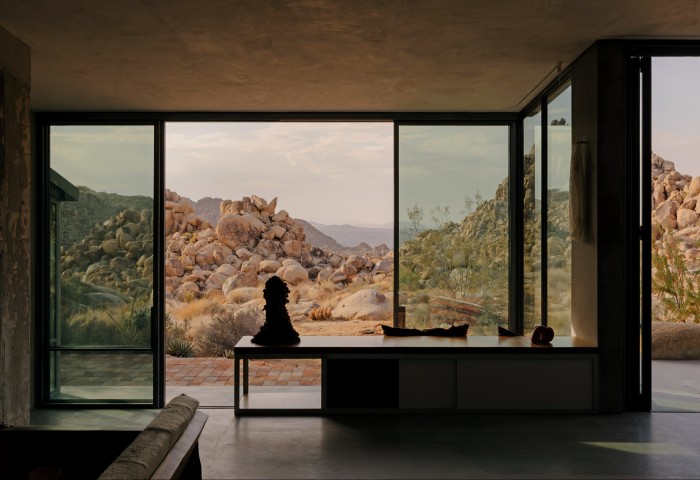
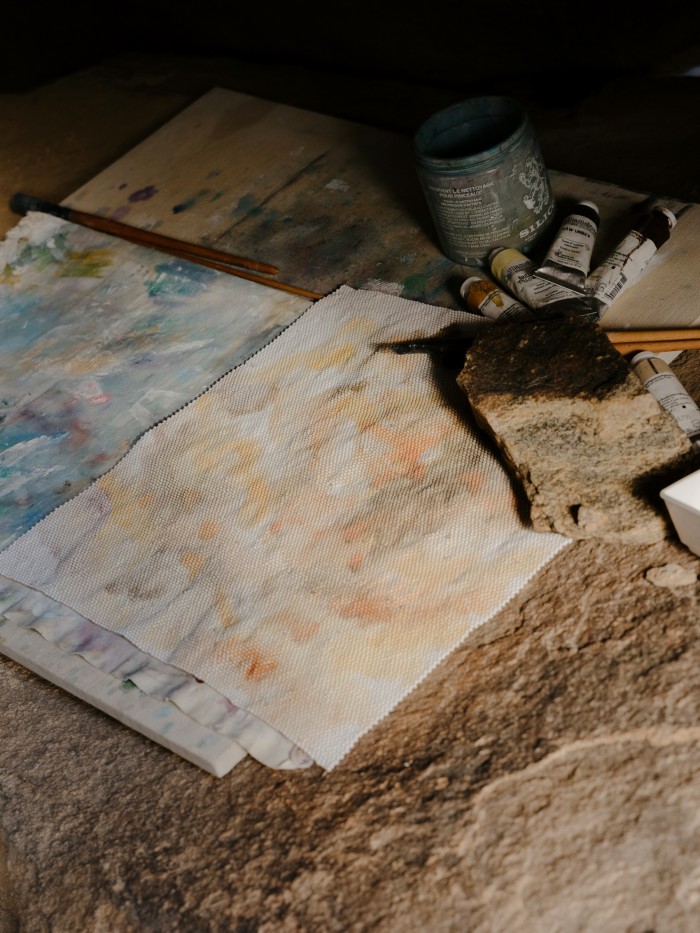
Lou’s early childhood was spent in Minnesota and is the subject of a mesmerising performance piece, Born Again. The rare departure from her beadwork tells the story of growing up in an evangelical household; her monologue is by turns funny and horrifying, full of fire and brimstone, violence and snatches of gospel singing. When the video was shown at White Cube in 2006 it was accompanied by beaded pieces such as the razor-wire-topped Security Fence (2005) and Cell (2004-2006), a recreation of a death-row prison cell. Lou refers to these as “dystopic”: “I was disillusioned, making work about the American landscape, about incarceration. I was thinking about Guantanamo, about Afghanistan and Iraq after 9/11.”
In the midst of this period, Lou moved from LA to South Africa, and maintained a studio there until January 2020. Believing her beading practice could create jobs in high-crisis areas, she approached Aid To Artisans, which directed her to KwaZulu-Natal, a province at the epicentre of the HIV epidemic and with 75 per cent unemployment in its townships. “I literally packed up the beads and moved,” says Lou. “It was an impulsive decision, and it turned out to be the most extraordinary experience of my life.” It was here, while working with a collective of Zulu women, that her work became more abstract, from bead-woven colour-field canvases to a series of 1,000 white “dishcloths”.
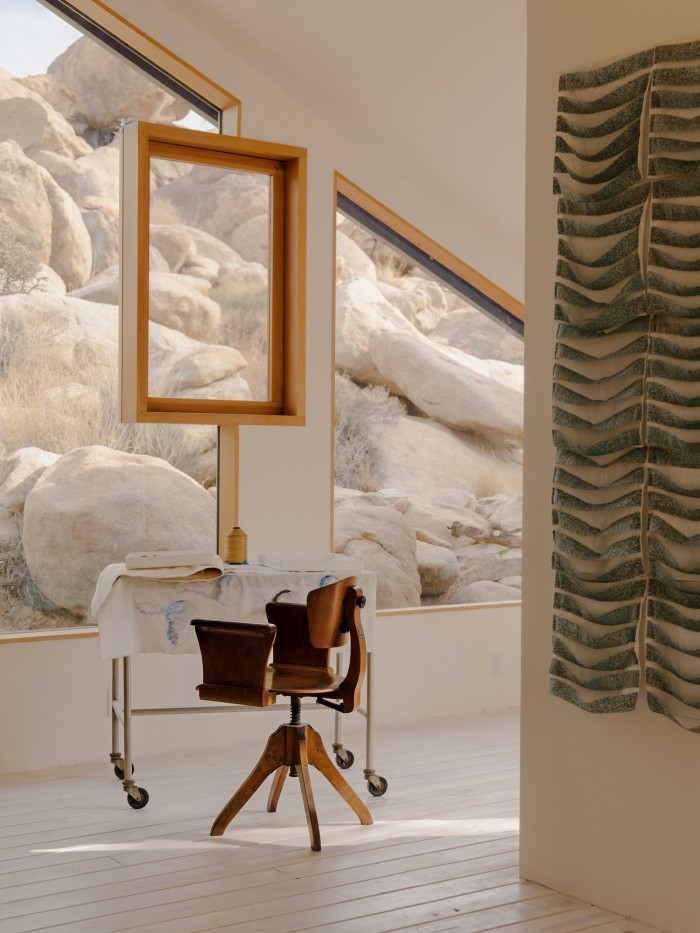
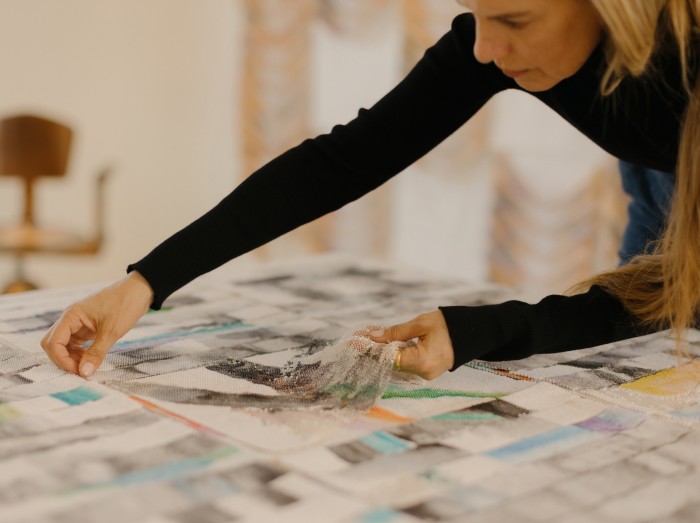
“In my abstract work, I’ve tried to ask whether it’s possible to take minimalism and bring a sense of humanity to it, a sense of warmth,” says Lou. “We think of minimalism as being kind of cold, but can it contain the sweat and the oil of the hand, the saliva from threading the needle, the human touch?” This question continues to resonate in her work, but it’s also at the heart of a parallel project: the renovation of the Joshua Tree home she shares with her husband Mick Haggerty – a graphic artist who has created album covers for David Bowie and Jimi Hendrix – and their 14-year-old daughter. “Mick asks the same question with architecture. He sort of says, can you take the prompts of, say, Bauhaus or Marfa – you can’t get away from Marfa when you’re working on something in the desert – and bring warmth to that? He’s always interested in creating something that has a tactile quality, something kind of sexy, something you’d want to make love to,” laughs Lou. “For us, this property is a real culmination of our partnership of over 20 years.”
The couple purchased the compound of four buildings from a local ceramicist in 2018. “The studio was already here. It’s Moorish-looking, a bit odd,” says Lou, highlighting one of their few interventions to the space – a window within a window “so you can open it without losing the larger picture”. The main house she refers to as a bunker. “It’s all concrete and was painted in multiple colours that we sandblasted off, stripping it back to its raw elements so that the landscape could come into the space, so that you are living with nature, not trying to triumph over it.” A run of steel-framed, floor-to-ceiling windows along the length of the building is a prime example of how the design showcases the setting.
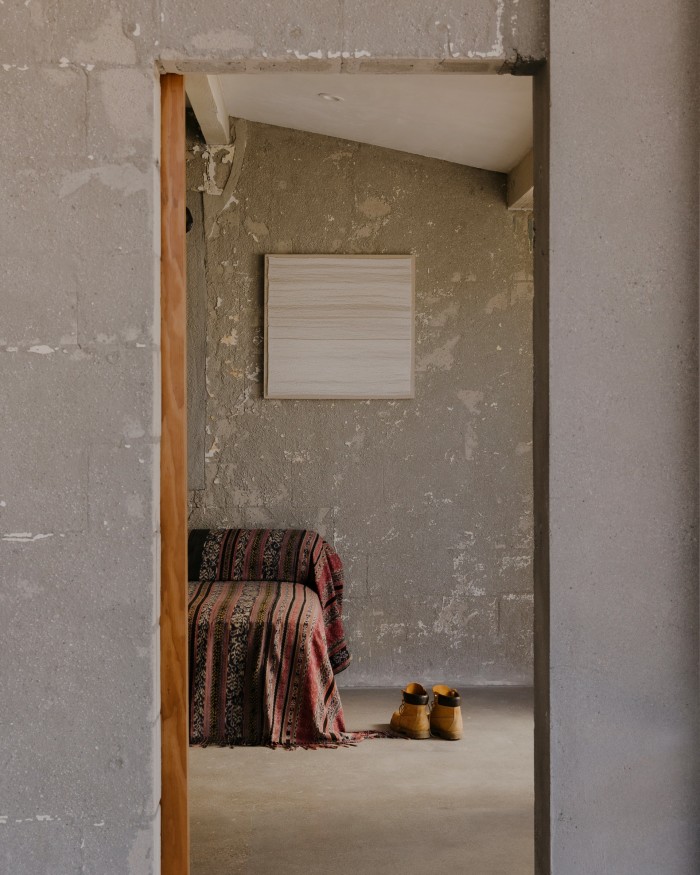
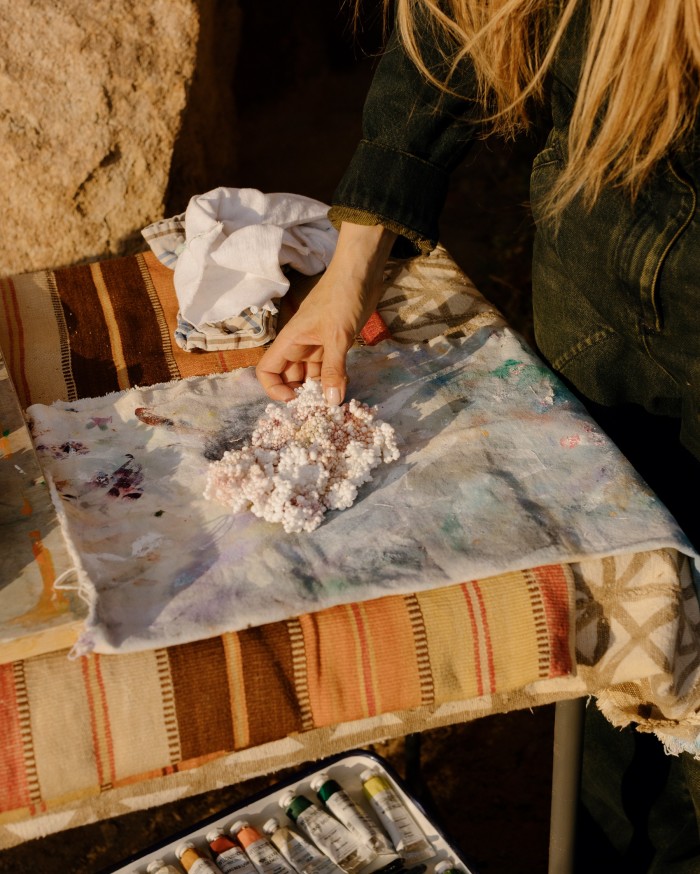

“As a family of artists, we think about all the spaces, even the living spaces, in terms of making,” says Lou. The majority of the interior details are site specific, designed by Haggerty, while the sinuous walnut dining table and hand-carved stools are the work of self-taught sculptor (and one-time Joshua Tree resident) Alma Allen; and the modernist chair and coffee table in the living room are by Dutch designer Gerrit Rietveld. The furniture is offset by glorious artworks; a painted clay sculpture by Ken Price reflects the desert landscape, and a lithograph by Bruce Conner of the word Applause hangs near the espresso machine in the kitchen. But on the whole, the wall space belongs to Lou. “Mick has created the perfect environment not only for me to make art but also to show my art,” she says. “It’s a beautiful little bunker-chapel. The surfaces of my canvases tend to be reflective and highly wrought, but the walls are all rough, really essential, and that tension between the two is lovely for me to live with and think about.”
Lou’s new work is currently on show at Lehmann Maupin gallery in London. “You can see a precipitable shift in the way she is working with light and colour,” says gallery co-founder David Maupin. “I’ve watched as Liza’s practice has taken on a new relationship to the desert and, in turn, opened up conversations connecting her work to the land. She’s infusing her work with a sense of place. It’s a shift that has been propelled by the pandemic: Liza, working alone, amid the backdrop of the high desert.”
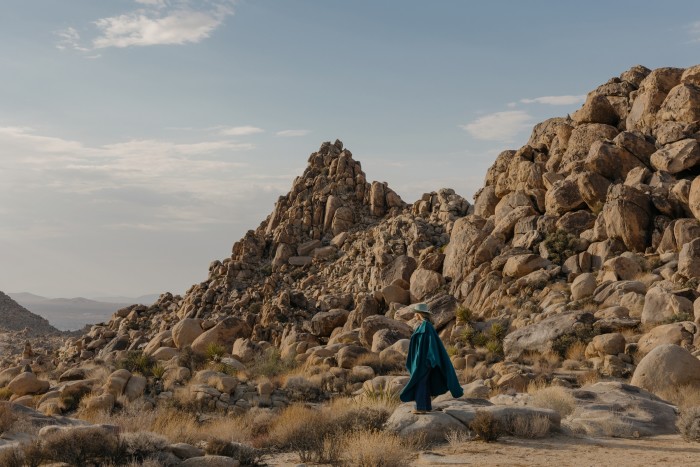
In several pieces, beaded strips that once were woven tightly across a canvas hang loose, indicating, says Lou, “a loosening of the idea of how things should go, a letting go of control. This, for me, has been the great lesson of this time.”
One such piece of bandage-like strips sitting atop pools of dusky colour is titled Going to California; another more regimented composition, twinkling in a sky-scape of blues, is called Into the Mystic. Is this those cosmic desert vibes coming through? “I mean, that vision-quest aspect has seeped its way in pretty deep at this point, I’m pretty embarrassed to say,” laughs Lou. “But I think that we fall more on the Zabriskie Point aspect,” she says, referencing Michelangelo Antonioni’s 1970 film set in the Mojave desert and featuring a particularly impressive home perched atop a boulder outcrop. “At the end of the movie the whole house blew up, so I don’t know what’s going to happen. But while it’s here, I’m just going to enjoy it.”
Liza Lou, Desire Lines is on until 6 November at Lehmann Maupin, 1 Cromwell Place, London; lehmannmaupin.com
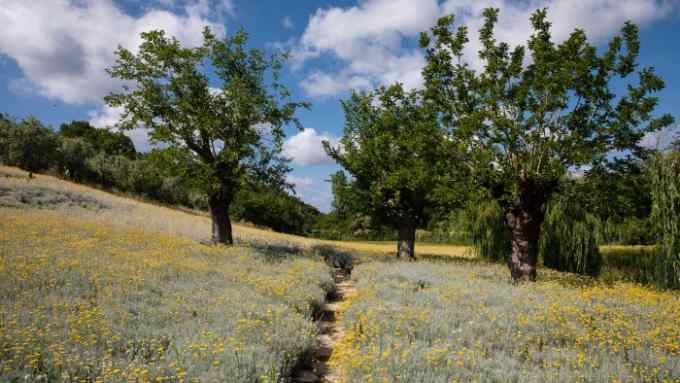
Comments